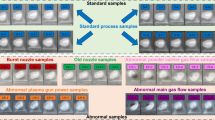Abstract
In this paper, to address the problems of poor signal noise reduction and low recognition rate in wire rope leakage magnetic detection. We propose the algorithm MSVDW, which uses a combination of median filtering, singular value decomposition (SVD) and wavelet transform, to denoise the collected three-dimensional MFL signals. Then, false color is used to enhance the image. The image is then localized and segmented using the modulus maximum method. The color moments are extracted from the images and used as the input of the particle swarm algorithm optimized support vector machine (PSO-SVM) for training and recognition. The experimental results show that the noise reduction algorithm proposed in this paper effectively reduces the noise of the magnetic leakage signal, the false color image enhances the defect image information, and the algorithm of PSO-SVM greatly improves the recognition rate of defects.








Similar content being viewed by others
REFERENCES
Min, Z., Research on Key Technologies of Quantitative Detection of Magnetic Leakage in Local Defects, Shock Vibrat., 2012, vol. 2019. https://doi.org/10.7666/d.D243446
Tse, P.W. and Rostami, J., Advanced signal processing methods applied to guided waves for wire rope defect detection, AIP Conf. Proc., 2016, vol. 1706.
Zhang, D., Zhou, Z., Sun, J., Zhang, E., Yang, Y., and Zhao, M., A Magnetostrictive Guided- Wave Nondestructive Testing Method With Multifrequency Excitation Pulse Signal, IEEE Trans. Instr. Meas., 2014, vol. 63, no. 12, pp. 3058—3066. https://doi.org/10.1109/tim.2014.2324812
Yan, X., Zhang, D., and Zhao, F., Improve the signal to noise ratio and installation convenience of the inductive coil for wire rope nondestructive testing, NDT & E Int., 2017, vol. 92, pp. 221—227. https://doi.org/10.1016/j.ndteint.2017.09.005
Bernieri, A., Betta, G., Ferrigno, L., Laracca, M., and Mastrostefano, S., Multifrequency Excitation and Support Vector Machine Regressor for ECT Defect Characterization, IEEE Trans. Instr. Meas., 2014, vol. 63, no. 5, pp. 1272–1280. https://doi.org/10.1109/tim.2013.2292326
Chen, H., Wang, C., and Zuo, X., Research on methods of defect classification based on metal magnetic memory, NDT & E Int., 2017, vol. 92, pp. 82–87. https://doi.org/10.1016/j.ndteint.2017.08.002
Li, J.Y., et al., Literature Review of Research on the Technology of Wire Rope Nondestructive Inspection in China and Abroad, MATEC Web Conf., 2015, vol. 22. https://doi.org/10.1051/matecconf/20152203025
Sharatchandra Singh, W., Rao, B.P.C., Mukhopadhyay, C.K., and Jayakumar, T., GMR-based magnetic flux leakage technique for condition monitoring of steel track rope, Insight Nondestr. Test. Cond. Monit., 2011, vol. 53, no. 7, pp. 377–381. https://doi.org/10.1784/insi.2011.53.7.377
Jomdecha, C. and Prateepasen, A., Design of modified electromagnetic main-flux for steel wire rope inspection, NDT & E Int., 2009, vol. 42, no. 1, pp. 77—83. https://doi.org/10.1016/j.ndteint.2007.10.006
Fedorko, G., Molnár, V., Ferková, Ž., Peterka, P., Krešák, J., and Tomašková, M., Possibilities of failure analysis for steel cord conveyor belts using knowledge obtained from nondestructive testing of steel ropes, Eng. Fail. Anal., 2016, vol. 67, pp. 33–45. https://doi.org/10.1016/j.engfailanal.2016.05.026
Park, S.H., Kim, J.W., Nam, M.J., and Lee, J.J., Magnetic flux leakage sensing-based steel cable NDE technique incorporated on a cable climbing robot for bridge structures, Adv. Sci. Technol., 2012, vol. 83, pp. 217—222. https://doi.org/10.4028/www.scientific.net/AST.83.217
Sun, Y., Liu, S., Li, R., Ye, Z., Kang, Y., and Chen, S., A new magnetic flux leakage sensor based on open magnetizing method and its on-line automated structural health monitoring methodology, Struct. Health Monit., 2015, vol. 14, no. 6, pp. 583—603. https://doi.org/10.1177/1475921715604387
Zhang, J., Tan, X., and Zheng, P., Non-Destructive Detection of Wire Rope Discontinuities from Residual Magnetic Field Images Using the Hilbert-Huang Transform and Compressed Sensing, Sensors, 2017, vol. 17, no. 3. https://doi.org/10.3390/s17030608
Sun, Y., Liu, S., Ye, Z., Chen, S., and Zhou, Q., A Defect Evaluation Methodology Based on Multiple Magnetic Flux Leakage (MFL) Testing Signal Eigenvalues, Res. Nondestr. Eval., 2015, vol. 27, no. 1, pp. 1–25. https://doi.org/10.1080/09349847.2015.1039100
Yinni, C., Research on quantitative detection of local defects of steel wire rope based on magnetic flux leakage imaging principle, 2008, https://doi.org/CNKI:CDMD:1.2008.194712
Kim, J.-W. and Park, S., Magnetic flux leakage–based local damage detection and quantification for steel wire rope non-destructive evaluation, J. Intel. Mater. Syst. Struct., 2017, vol. 29, no. 17, pp. 3396–3410. https://doi.org/10.1177/1045389x17721038
Kim, J.W. and Park, S., Magnetic Flux Leakage Sensing and Artificial Neural Network Pattern Recognition-Based Automated Damage Detection and Quantification for Wire Rope Non-Destructive Evaluation, Sensors, 2018, vol. 18, no. 1. https://doi.org/10.3390/s18010109
Zhang, J., Peng, F., and Chen, J., Quantitative Detection of Wire Rope Based on Three-Dimensional Magnetic Flux Leakage Color Imaging Technology, IEEE Access, 2020, vol. 8, pp. 104165—104174. https://doi.org/10.1109/access.2020.2999584
Zheng, P. and Zhang, J., Quantitative nondestructive testing of wire rope based on pseudo-color image enhancement technology, Nondestr. Test. Eval., 2019, vol. 34, no. 3, pp. 221—242. https://doi.org/10.1080/10589759.2019.1590827
Panetta, K., Bao, L., and Agaian, S., A New Unified Impulse Noise Removal Algorithm Using a New Reference Sequence-to-Sequence Similarity Detector, IEEE Access, 2018, vol. 6, pp. 37225—37236. https://doi.org/10.1109/access.2018.2850518
Orengo, M.S.A.M., Similarity of color images, Proc. SPIE Int. Soc. Optical Eng., 1995, vol. 2420. https://doi.org/10.1117/12.205308
Funding
This work was partially supported by National Natural Science Foundation of China (Grant no. U2004163).
Author information
Authors and Affiliations
Corresponding author
Ethics declarations
The authors declare that they have no conflicts of interest.
Rights and permissions
About this article
Cite this article
Bing Li, Zhang, J. & Chen, Q. Quantitative Nondestructive Testing of Steel Wire Rope Based on Optimized Support Vector Machine. Russ J Nondestruct Test 57, 1008–1017 (2021). https://doi.org/10.1134/S106183092111005X
Received:
Revised:
Accepted:
Published:
Issue Date:
DOI: https://doi.org/10.1134/S106183092111005X




